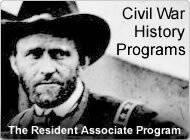
Biography - Washington Augustus Roebling - Civil War Engineer and Professional Civil Engineer
The Smithsonian Associates Civil War E-Mail Newsletter, Volume 3, Number 9
Emily Warren met her future husband, Washington A. Roebling, when he served on her eldest brother, General G. K. Warren's staff as an engineering officer. Under Warren's command, Roebling built two strategically significant suspension bridges, one at the Rappahannock River and another on the Shenandoah River at Harper's Ferry. He is credited with several amazing feats during the Civil War. From a hot air balloon on a sunny late-June morning in 1863, Roebling was the first to spy Robert E. Lee's army heading toward Gettysburg. During the ensuing battle, when General Warren ordered that Little Round Top be reinforced, Roebling helped place the first cannon, which effectively defended the site and directly contributed to the subsequent Union victory. He was awarded three brevets for gallant conduct and ended his military career as a Colonel.
After the war when he and Emily married, Roebling returned to the family wire manufacturing and bridge building business, John A. Roebling's Sons, Co. His father, John A. Roebling, had begun the Brooklyn Bridge project in 1869; a massive undertaking which would not be completed for another 14 years. At his father's death, Washington took over the business and directly supervised construction of the underwater caissons upon which the bridge's massive towers would be built. Because of this underwater work, he was stricken several times with what we now know as decompression sickness, or the bends. In 1879 he became totally disabled from it and was no longer able to work. By this point, the bridge was a highly charged financial and political albatross.
To keep the wolves at bay, to shield her husband during his illness, and to keep the Roebling name in the forefront of this tremendously important engineering feat, Emily Roebling stepped in and effectively, though unofficially, became Chief Engineer of the Brooklyn Bridge. What kind of credentials could she possibly have to do this? She read and filed every scrap of news about the bridge since the beginning and she worked at her husband's side during the entire construction effort. With Emily, Washington discussed the detailed blueprints, and with her he shared all of his and his father's bridge building plans and dreams. When a board of inquiry was convened by the American Society of Civil Engineers to determine if Washington Roebling should be removed as Chief Engineer, Emily's competence in managing the work to that date convinced them that the Roeblings should remain in charge.
The bridge opened on May 24, 1883 to parades, bands, politicians, gala dinners, a display of fourteen tons of fireworks, and a speech by President Chester A. Arthur. It was called the "Eighth Wonder of the World." Newspaper accounts tell us that on that day Emily appeared beautiful and vivacious. Washington Roebling, the Civil War hero and official Chief Engineer of the Brooklyn Bridge, appeared pale, showed no excitement, and could stand for only ten minutes at a time.
But Washington Roebling recovered, although he continued to live in great pain. In a strange twist of fate, he outlived his wife Emily by over 20 years, and he even remarried. He was over 80 years old when he again became president of John A. Roebling's Sons Co; he was the only Roebling left, having outlived his younger brothers and even their sons. At the beginning of the 20th century, John A. Roebling's Sons was the largest wire business in the world. The company was the major provider of telegraph wire, balling wire, electrical wire, bridge cable wire, wire for ships; and, it was the exclusive provider of wire for the Panama Canal and the Otis Elevator Company. Roebling actively, innovatively, and forcefully ran the business until his own death in 1926.
Obviously, Washington Roebling was an extremely energetic and intellectually charged individual. For diversion, he directed these energies into his lifelong hobby and passion, his rock and mineral collection. That priceless 16,000-piece collection was eventually donated by his son, John A. Roebling II, to the Smithsonian Institution. It has since become the cornerstone of the Museum of Natural History's mineral and gem collection.
Have we gone on a little too long about engineers, the Roeblings and the Brooklyn Bridge? Well, it's a great story. And we've done so in honor Engineers' Week, February 18-24, 2000. Take an engineer to dinner! Or at least have dinner ready when she or he gets home.

